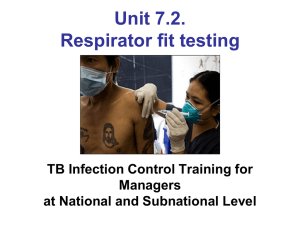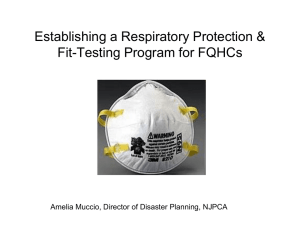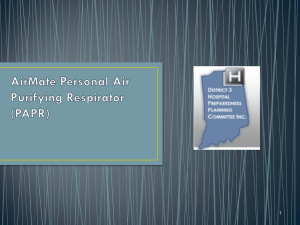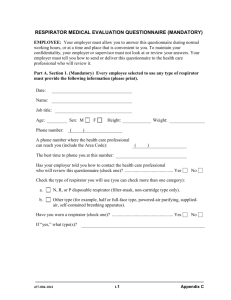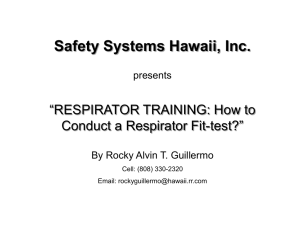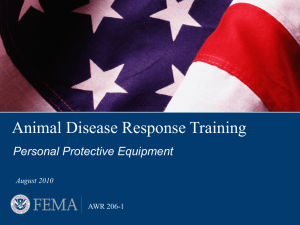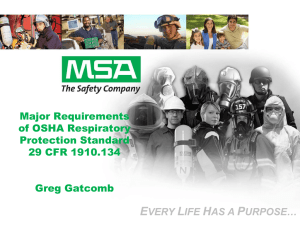Medical certification fro respirator use
advertisement
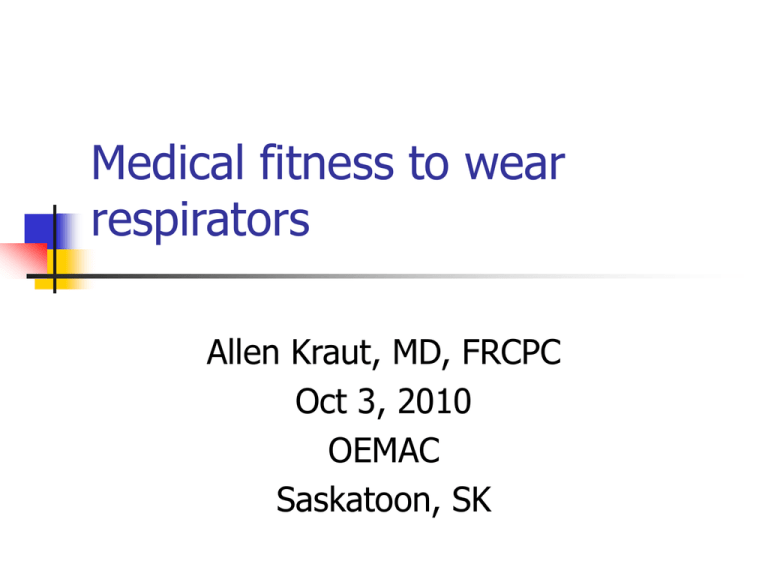
Medical fitness to wear respirators Allen Kraut, MD, FRCPC Oct 3, 2010 OEMAC Saskatoon, SK Respirator program CSA Z94.9-02 Roles and responsibilities Hazard assessment Selection of appropriate respirator Health surveillance Respirator fit testing Training Maintenance and storage Program evaluation Record keeping Is the worker medically fit to use a respirator? Detailed reports on respirator programs but no guidance on medical decisions. OSHA similar approach to CSA What information is needed to make a decision? Worker’s health status Type of respirator Type of work Physical level Environments IDLH Other protective equipment What health information influences decision? Physiologic conditions Pulmonary conditions Cardiac conditions Symptoms Psychological issues Safety issues Environment - Immediately toxic or oxygen deficient atmospheres Communication – Hearing, Vision Loss of consciousness Seizure disorder, diabetic on insulin Past ability to tolerate a respirator What health information influences decision? Seal issues Psychological -Claustrophobia Respiratory - cough Facial - deformities ? beard Physiologic effects of a respirator -ve pressure air purifying Pulmonary Increased resistance Increased tidal volume, decreased breathing frequency, decreased alveolar ventilation Submaximal workloads effects small Maximal workloads may be decreased by 10%. How does using a –ve pressure respirator affect individuals with respiratory disorders? Mild to moderate obstructive and restrictive respiratory defects Subtle effects Not sensitive or specific for determining fitness to use a respirator PFT abnormalities 27 yo female geologist with cystic fibrosis wishes to be hired by a mining company as a field tester. She has worked for a contractor doing similar work in the mine for the last three years with according to her, no problems. She reports using a half face mask cartridge respirator regularly in the past with no problems. Her FEV1 is 0.77 L 25% predicted and FVC is 0.92 L 54% predicted, the ratio of FEV1/FVC is 40%. Is she fit to wear a half face mask cartridge respirator? PFT abnormalities 1. Fit to wear the suggested respirator 2. Fit with restrictions/conditions 3. Fitness decision needs to deferred until additional information is available. What restrictions/conditions? What information? 4. Unfit to wear the suggested respirator. Q1 PFTs 12 10 Fit 8 Restrictions/condit ions Deferred more info 6 4 Unfit 2 0 N =22 Restrictions/conditions 3 could do tasks 1 air powered, fresh air supply Deferred 1 check pfts to follow decline 2 speak to respirologist 3 more info on job and person 1 blood gas, diffusion 2 trial of respirator 2 get out in emergency My answer #3 1. Verified that she could wear her respirator and do her work 2. Verified her sickness absences 3. Verified that she could exit the mine. Q1 PFTs 16 14 Fit 12 10 Restrictions/condit ions Deferred more info 8 6 Unfit 4 2 0 N =23 After verification #2 Restrictions/conditions 1. Only fit for current job 2. Needed to report any significant change in medical condition 3. Needs to provide a letter yearly from her physician stating that her condition has not deteriorated What PFT measurement gives the best overall assessment of lung function? FEV1 > 60% predicted - trial of respirator Lower levels for light duties ATS guidelines Am J Respir Crit Care Med 1996 154:1153-1165 How often do PFTs help in the certification decision? 5,569 workers DOE facility 98.7% no restriction 71 (1.3%) restrictions 5 (0.1%) solely on basis of PFTs Pappas et al AJIM, 1999;35:390-94 Can questionnaires screen out people who do not need further assessment? YES 49/413 abnormal PFTs only 1 case did it influence decision Pappas et al, AJIM 1999;35:395-400 Pregnancy 27 yo Female 16 week pregnant works in a aircraft manufacturing facility. A variety of solvent based compounds are used and air measurements for all of them are < 2% of the TLV. Cartridge respirators are optional in this workplace. Alternative work is not available and she wishes to wear a cartridge respirator for about two hours a day when she feels her exposures would be greatest. Is she fit to wear a negative pressure respirator? Pregnancy 1. Fit to wear the suggested respirator 2. Fit with restrictions/conditions 3. Fitness decision needs to deferred until additional information is available. What restrictions/conditions? What information? 4. Unfit to wear the suggested respirator. Q2 Pregnancy 14 12 Fit 10 6 Restrictions/condit ions Deferred more info 4 Unfit 8 2 0 N =22 Restrictions/conditions 2 concerned about solvents 1 fit tested can change in pregnancy 1 personal monitoring and monthly assessment of fitness Deferred 1 assess workload 2 more medical info past pregnancies 1 list exposures 1 pft 1 fit may change during pregnancy 1 concerned re solvents Q2 Pregnancy 18 16 Fit 14 12 Restrictions/condit ions Deferred more info 10 8 6 Unfit 4 2 0 N =22 My answer #1 Issues 1. Does pregnancy affect the ability to wear a respirator? 2. Is the pregnant worker at risk if the respirator fails? Does pregnancy affect the ability to wear a respirator? Israeli study – Gulf War 48 pregnant women wearing gas masks 24 during labour and delivery. No decrease in maternal po2 Mild tachypnea No fetal heart rate abnormalities. Delivered babies did well Apgar > 8 at 1’ Can J. Anaesthesia 1992;39:895-96. Seizure disorder 28 yo male with a history of head trauma and residual seizure disorder wishes to work in maintenance at a food processing plant. He has no other neurologic sequelae from his injury and is otherwise well. His work involves intermittently using a negative pressure cartridge respirator when exposed to irritants and six times per year using an SCBA to clean the inside of large vats. This is quite hard work. He supplies a note from his physician stating that he is compliant with his medication and that his drug levels are in the therapeutic range. His last seizure was 6 months prior when he was up all night due to travel arrangement complications during a trip. His last seizure prior to that was 18 months previous. He has had an aura prior to previous seizures. Is he fit to wear the respirators required for his job? Seizure 1. Fit to wear the suggested respirators 2. Fit with restrictions/conditions 3. Fitness decision needs to deferred until additional information is available. What restrictions/conditions? What information? 4. Unfit to wear the suggested respirators. Q3 Seizure 12 10 Fit 8 Restrictions/condit ions Deferred more info 6 4 Unfit 2 0 N =22 Restrictions/conditions 2 Needs longer seizure free period 1 yr , 2 yr 4 No SCBA 4 Can’t work alone Deferred 1 consult neurologist 1 CV fitness, can’t work alone 1 Is this a unionized environment? If so he will have to be approved as an arbitrator would declare him to be fit if tested at a hearing as it would be. The cost of an arbitration is usually $15,000, so to save the waste of that money he would be approved without further ado. 1 can he drive? Q2 Seizure Issue SCBA 12 10 Fit 8 Restrictions/condit ions Deferred more info 6 4 Unfit 2 0 N =22 Seizure free periods- after diagnosis of epilepsy Private driver - 6 –12 months seizure free compliant patient on medication Commercial driver- five years NFPA 5 years seizure free Safety sensitive jobs in railway – 5 years Seizure My answer #1 Frequency of seizures Compliance with treatment Precipitating circumstances Presence of warning symptoms Asthma 45 YO Male egg processing manager develops occupational asthma secondary to exposure to egg proteins. At diagnosis he presented to ER. With appropriate treatment he is feeling well and has had no further hospital visits. Pre-bronchodilator spirometry shows mild obstruction which resolves with salbutamol. The man does not want to change careers because he feels he will not be able to replace his income. He is able to limit, but not eliminate his exposure to the egg proteins at work. Should be allowed to work wearing a negative pressure respirator while exposed to eggs? Asthma 1. Fit to wear the suggested respirator 2. Fit with restrictions/conditions 3. Fitness decision needs to deferred until additional information is available. What restrictions/conditions? What information? 4. Unfit to wear the suggested respirator. Q3 Asthma 10 9 8 7 6 5 4 3 2 1 Fit Restrictions/condit ions Deferred more info Unfit 0 N =22 Restrictions/conditions 4 medical follow up, spirometry, methacholine challenge, symptoms 1 fit testing 3 concerned about exposure if sensitized should not be exposed Deferred 1 on the job evaluation 1 pre post pfts 1review history no anaphylactic reactions 1 Need spirometry would follow post exposure 1 how long since diagnosis, PAPR Q2 Asthma 14 12 Fit 10 6 Restrictions/condit ions Deferred more info 4 Unfit 8 2 0 N =22 Occupational immunologic asthma Ideally stop exposure Stopping exposure may be associated with loss of income ? PPE Asthma –irritant or non occupational Protects against exposure Harber (JOEM 2010)Asthmatics may report more symptoms with cartridge respirators. If the respirator is not used properly increased exposure to irritants ? Asthmatic attack. Asthma #2 Conditions –Needs medical follow up q 6 months for lung function testing and methacholine challenge while working with potential exposure. Continued working for 15 years, no persistent decline in PFTs. Laid off, could not find permanent work. SCBA 45 yo male with history of Type II diabetes on metformin, obesity (BMI 32), mild hypertension, smoking ½ ppd, normal cholesterol is referred for respirator certification. He works in a chemical plant and he needs to wear an SCBA for emergency circumstances in case there is a spill and he has to rescue a co-worker. He has no history of cardiac disease or symptoms suggestive of angina. His father had an MI at age 67. Is he fit to wear an SCBA respirator? Cardiac risk factors. 1. Fit to wear the suggested respirator 2. Fit with restrictions/conditions 3. Fitness decision needs to deferred until additional information is available. What restrictions? What information? 4. Unfit to wear the suggested respirator. Q3 Cardiac Risk 12 10 Fit 8 Restrictions/condit ions Deferred more info 6 4 Unfit 2 0 N =22 Restrictions/conditions Deferred 1 practical test 8 cardiac stress 2 more medical info 3 pfts 1 no facial hair Q3 Cardiac Risk 12 10 Fit 8 Restrictions/condit ions Deferred more info 6 4 Unfit 2 0 N =22 SCBA cardiac risk factors Although likelihood of needing SCBA is low, needs to be able to use it. Need further information Exercise test If negative then ok. How should respirator certification decision be made? No clear guidelines Tolerance more dependent on comfort and psychological factors than physiologic measures In general, if a worker is healthy enough to do the job without a –ve pressure respirator he/she should be able to perform the work with a respirator. Past experience best guide. How should a decision be made? Estimate the likelihood of an unacceptable adverse outcome. If no clear contraindications, trial and observe at work or in simulated situation If a worker reports difficulties try a different type of respirator Conclusions The vast majority of people who can work, can tolerate a –ve pressure air purifying resp. Issue is usually fitness to work not fitness to wear respirator Questionnaires can be used to screen people who require more intense evaluation Conclusions PFTs useful only in workers with symptoms or history suggestive of lung disease. May be needed for surveillance purposes. Worker’s should not be restricted from using –ve pressure respirators solely based on spirometry results. Conclusions IDLH environments, emergency workers, SCBA users require more intense evaluation Cardiac Pulmonary Musculoskeletal Seal issues Post certification follow up would be useful to identify if worker having problems with a respirator
